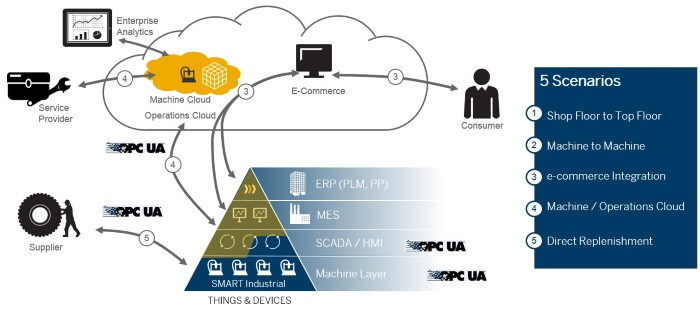The market increasingly demands individualized products. Product life cycles are getting shorter and average lot sizes are getting smaller. Considering this, cost efficient production in a globalized and resource limited environment requires a highly flexible (IT-) infrastructure that also works well in cross-enterprise networks.
An objective must be, to bring the world of business data and the world of automation data much closer together in order to reduce the number of media breaks and the number of isolated applications. In addition to that, the combined data will be the basis for completely new insights.
The classical automation pyramid paradigm is due to its strict and hierarchic separation into Enterprise Resource Planning (ERP), Manufacturing Execution System (MES), Supervisory Control and Data Acquisition (SCADA) and Machine/Device outdated. The different data models of each layer need to intermesh more seamless than in the past and at the same time, the interoperability needs to consider new processes with regard to interaction with customers, suppliers and service providers.
Hence, manufacturing companies have to accept the challenge to transform their IT landscape in such a way, that various scenarios of interoperability can be managed while being ready for continuous and easy adaption to new requirements.
The central foundation of a promising strategy for the digital transformation should be given to the standardization of communication protocols.
A bidirectional connection of machines to other software is very often rather difficult because only vendor-specific, proprietary protocols and interfaces are provided. Although there have been for quite some time various efforts and approaches to harmonize the variety of M2M protocols and although there is a certain urgency and necessity for more flexibility and openness of IT systems in production environments, still far too often those arguments gain acceptance which prefer the closed system bundle of asset plus SCADA/line-server from the hands of a single provider.
And that regardless of the availability of the Unified Architecture of Open Platform Communications – short OPC UA, an M2M communications architecture which could be the perfect basis to bridge the gap between machine and business layer. OPC UA provides not only the means to transport machine data (e.g. set-points, measured values, parameters) it has also the unique feature to semantically describe the data. Thanks to the OPC UA information model, new processes between a PLC and any higher-level, business-oriented software layer can be established in very short time.
Set-points and control-variables could be easily maintained and centrally administrated as natural part of the material master data and even customer order specific information could be directly exchanged with the PLC instead of replicating the data across different software layers. Providing measurement and process details as enhancement of business documents for comprehensive analytics is also an easy task as soon as the connectivity is standardized.
That the proficient implementation of the OPC UA specification offers even further possibilities is shown by a demonstrator, which the co-innovation partners and technology leaders SAP (Enterprise Software), Beckhoff Automation (Automation Technology), Elster-Kromschröder (Measurement Technology), Asentics (Machine Vision for Factory Automation), Stäubli (Robotic Technology) and CAB (Industrial Printing Technology) present at the Hannover Messe 2016.
Based on a Beckhoff XTS (eXtended Transport System) a machine will assemble personalized products in lot size 1 while configuration and automation related master data will be received directly from the SAP Manufacturing Execution software.
This vertical integration alone would be far from striking, as already several progressive companies make use of such concepts and confirm the value of OPC UA. Spectacular is rather that each component of the demonstrator (transport system, robots, cameras, printers, measuring technology) serves as an independent machine unit, which each acts for itself as OPC UA Server and OPC UA client. The autonomous units are orchestrated by SAP Plant Connectivity (PCo) – itself again OPC UA server and client at the same time. In this way, each machine unit can deploy as needed OPC UA methods, events or data points (tags) that publish the respective responsibilities and capabilities of the unit as a service.
Instead of the traditional way to couple the machine units by means of a single, “hardwired” PLC program, SAP PCo orchestrates the components from the perspective of operational necessity. This layers knows the individual routing for a production order and can – for example- instruct the machine to skip an operation X for product Y or to trigger a robot to execute job configuration A for a product B. At the same time, a machine unit could automatically obtain information by calling the provided OPC UA methods of each other building block. Vertical and horizontal integration is evolved into flexible networks.
Leveraging this idea of combined OPC UA Server and Client means, that in future production facilities can be easily enhanced and adapted. The new mind-set for planning and operating complex automation systems will focus on Service Oriented Architectures.
